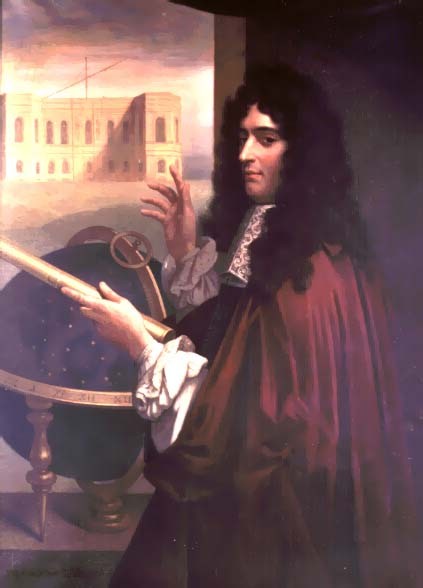- Giovanni Domenico Cassini
Infobox_Scientist
name = Giovanni Domenico Cassini
 |300px
|300px
image_width = 260px
caption = Giovanni Domenico Cassini
birth_date = birth date|1625|06|08|mf=y
birth_place =Perinaldo ,Republic of Genoa
death_date = death date and age|1712|09|14|1625|06|08|mf=y
death_place =Paris ,France
residence =Italy
nationality = flagicon|Italy Italian (1625-1673)
flagicon|France French (1673-1712)
field =mathematics ,astronomy ,engineering , andastrology
work_institution =University of Bologna
alma_mater = The Jesuit College at Genoa
doctoral_advisor =
doctoral_students =
known_for =
prizes =
religion =Roman Catholic
footnotes =Giovanni Domenico Cassini (
June 8 ,1625 –September 14 ,1712 ) was an Italianmathematician ,astronomer ,engineer , andastrologer . Cassini, also known as Giandomenico Cassini, was born inPerinaldo , nearSanremo , at that time in theRepublic of Genoa .Astronomer
Cassini was an astronomer at the
Panzano Observatory , from 1648 to 1669. He was aprofessor of astronomy at theUniversity of Bologna and became, in 1671, director of theParis Observatory . He thoroughly adopted his new country, to the extent that he became interchangeably known as Jean-Dominique Cassini —although that is also the name of his great-grand-son.Along with
Robert Hooke , Cassini is given credit for the discovery of theGreat Red Spot onJupiter (ca. 1665). Cassini was the first to observe four ofSaturn 's moons, which he called "Sidera Lodoicea "; he also discovered the Cassini Division (1675). Around 1690, Cassini was the first to observedifferential rotation within Jupiter's atmosphere.In 1672 he sent his colleague
Jean Richer toCayenne ,French Guiana , while he himself stayed inParis . The two made simultaneous observations ofMars and thus found itsparallax to determine its distance, thus measuring for the first time the true dimensions of thesolar system .Cassini was the first to make successful measurements of
longitude by the method suggested by Galileo, using eclipses of thesatellite s of Jupiter as a clock.Astrologer
Attracted to the heavens in his youth, his first interest was in
astrology rather thanastronomy . Later in his life he focused almost exclusively on astronomy alone and all but denounced astrology as he became more and more involved in theScientific Revolution . While young he read widely on the subject of astrology, and soon he was very knowledgeable about it; it was his extensive knowledge of astrology that led to his first appointment as an astronomer.Panzano Observatory position
In 1645 the Marquis
Cornelio Malvasia , who was a senator ofBologna with a great interest in astrology, invited Cassini to Bologna and offered him a position in the Panzano Observatory which he was constructing at that time. Most of their time was spent calculating newer, better, and more accurate ephemerides for "astrological purposes" using the rapidly advancing "astronomical methods" and tools of the day.Moving to France
In 1669 Cassini moved to France and through a grant from
Louis XIV of France helped to set up theParis Observatory which opened in 1671; Cassini would remain the director of the observatory for the rest of his career until his death in 1712. In 1673 he became a French citizen. For the remaining forty-one years of his life Cassini served as astronomer/astrologer to Louis XIV ("The Sun King"); serving the expected dual role yet focusing the overwhelming majority of his time on astronomy rather than the astrology he had studied so much of in his youth.During this time, Cassini's method of determining longitude was used to measure accurately the size of France for the first time. The country turned out to be considerably smaller than expected, and the king quipped that Cassini had taken more of his kingdom from him than he had won in all his wars.
Engineering
Cassini was employed by
Pope Clement IX in regard tofortification s,river management , andflood ing of thePo River .The Pope asked Cassini to take
Holy Orders to work with him permanently but Cassini turned him down because he wanted to work on astronomy full time.In the 1670s, Cassini began work on a project to create a topographic map of France, using
Gemma Frisius 's technique oftriangulation . The project was continued by his sonJacques Cassini and eventually finished by his grandsonCassini de Thury and published as theCarte de Cassini in 1789 [http://www.britannica.com/eb/article-9020657] or 1793 [http://www.madehow.com/Volume-4/Topographic-Map.html] . It was the first topographic map of an entire country.Bibliography
* Anna Cassini, "Gio. Domenico Cassini. Uno scienziato del Seicento", Comune di Perinaldo, 1994. (Italian)
*Giordano Berti (a cura di), "G.D. Cassini e le origini dell’astronomia moderna", catalogo della mostra svoltasi a Perinaldo -Im-, Palazzo Comunale, 31 agosto - 2 novembre 1997. (Italian)
* Giordano Berti e Giovanni Paltrinieri (a cura di), "Gian Domenico Cassini. La Meridiana del Tempio di S. Petronio in Bologna", Arnaldo Forni Editore, S. Giovanni in Persiceto, 2000. (Italian)Named after Cassini
* Cassini-Huygens Mission toSaturn
* The Cassini Division inSaturn 's rings
*Cassini Regio , dark area on Iapetus
* Cassini crater onMars
* Cassini crater on theMoon
*Cassini's Laws
*24101 Cassini , anasteroid
* Cassini's identity forFibonacci number s
*Cassini oval
* [http://www.asp.net/Projects/Cassini/Download/Default.aspx?tabindex=0&tabid=1 Cassini Web Server]External links
* [http://www.newadvent.org/cathen/03405b.htm Catholic Enyclopedia article]
*Persondata
NAME=Cassini, Giovanni Domenico
ALTERNATIVE NAMES=
SHORT DESCRIPTION=Astronomer, discovered Saturn moons and Great Red Spot of Jupiter
DATE OF BIRTH=1625-6-8
PLACE OF BIRTH=Perinaldo
DATE OF DEATH=1712-09-14
PLACE OF DEATH=Paris
Wikimedia Foundation. 2010.
